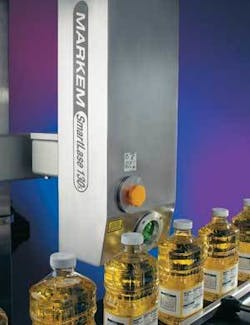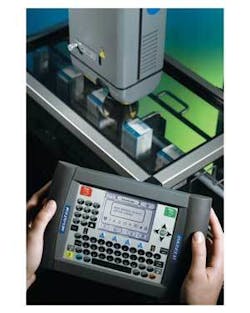Laser coding offers an attractive method for marking packaged consumer goods
Jeffrey J. Koczela
The most common technologies used in the coding and marking of products and packaged consumer goods apply ink, transfer a code, or apply a label to create the code or mark. However, recent technological advancements have allowed the entry of compact, low-power lasers into more mainstream coding and marking applications, giving manufacturers another attractive option for their product identification needs.
The difference
Instead of printing a code with ink or printing a label and then applying that label, laser coding technology utilizes the processes of ablation and engraving to remove or melt an image in material to produce a code that is high quality, permanent, and immediate. This technology provides manufacturers a cost-effective and efficient option for package coding and marking.
Figure 1. Lasers offer a cost effective, efficient option for package marking.
When compared to competitive forms of coding and marking consumer goods packaging, laser coding systems appear poised to become the packaging industry’s universal method of choice. What then are the qualities that have brought laser technology to its consistently increasing popularity? Key factors in favor of laser coding include: no consumable costs (for example, ink, solvents), minimal maintenance costs, less system downtime, reduced environmental impact due to its inkless process, the capability to code on a variety of substrates, and ease of integration.
Market changes
In addition, influences from changing market conditions in the packaging industry cause companies to search for coding technology solutions that conform to new industry standards. Companies are receiving increased mandates from their customers-such as large retail chains or regulatory agencies. These requirements include a higher number of coding details to enable traceability and reduce recall size and restrictions on usage of toxic materials, such as ink solvents in the manufacturing and coding process.
The packaging industry’s overall purchasing requirements for coding solutions normally focus mostly on reliability, flexibility, the quality of the code, cost effectiveness, and durability. Coding equipment offering these benefits would have no consumables, minimal maintenance, permanent and immediate codes, and the ability to place codes on a wide range of substrates. According to the results of a Packaging Machinery Buying Process Study done by Packaging Machinery Manufacturers Institute (PMMI), the top factors in machinery purchases are: reliability (up-time versus down-time), throughput, safety features, machine design, changeover time, ergonomics, total cost of machine operation, flexibility, and purchase price-all factors that make laser coding an attractive option.
Laser advantages
Laser coding clearly has its advantages, and patented dot matrix dwell technology from MARKEM Corporation combines this patented print technology along with a low-power CO2 laser to deliver high-quality images at tremendous line speeds. A method of cycling the laser less often, turning on and off only once during the printing of the entire code, makes dot matrix dwell technology reliable and ultimately cost efficient. The requirement for little routine maintenance combined with print performance that delivers sharp, immediate, and permanent codes makes laser coding a highly productive coding solution. SmartLase coders use these advantages to offer users the most cost-effective coding solution available today
Laser coding technology consistently offers significant advantages when compared to the current most popular form of coding technology, Continuous Ink Jet (CIJ). Some CIJ print systems have a high cost of operation-up to $6000 per year. These costs include $2000 per year for consumables and $3000 to $4000 per year for maintenance and disposal. System maintenance alone can take up to six hours per week along with start-up and shut-down times of up to an hour and loss of packaging due to code smearing because of wet ink and overall system downtime.
Figure 2. User-friendly WYSIWYG interface simplifies operation.
Laser coding technology is a flexible method of package marking as compared to other competing technologies offered in the market today. Its inkless process makes it clean and environmentally friendly. It also has the inherent capability to accomplish coding jobs with minimum downtime, due to the accessories, tools, and techniques that accompany the systems. Additionally, many industries-health and beauty, frozen foods, pet foods, pharmaceuticals, consumer products, and automotive components to name a few-require the digital data entry and permanent coding that lasers offer. A wide variety of codes-short or tall, narrow or wide, static or dynamic, graphic or simple text-can be printed on a large range of package sizes, and printing can be done in multiple orientations in a range of languages, on both continuous and intermittent lines.
Choosing the vendor
Once a decision has been made to choose laser coding systems or to investigate the possibility of adding to or updating older technology, selecting the right company to work with is equally important. Companies should seek an organization that is providing more than a product, but one that is also willing to act as a partner involved in all aspects of leveraging the most from its coding equipment. Some of these value-added areas include services to maximize uptime, productivity, and customer satisfaction, such as reliability programs; integrated logistics management systems; training; on-line support; and project management.
These activities combine and optimize a coding system’s performance and represent an integral part of the total package of benefits a partnership with the organization supplying the equipment provides. Taking full advantage of them assures that your experience will be productive and satisfying.
All predictions point to laser coding technology becoming more widespread. It’s also clear that when companies decide to employ this technology, they will realize improved overall productivity, a reduction in operating costs, and an increase in their overall product value.
Jeffrey Koczela ([email protected]) is the product management group leader-coding products for Markem Corp (www.markem.com).

